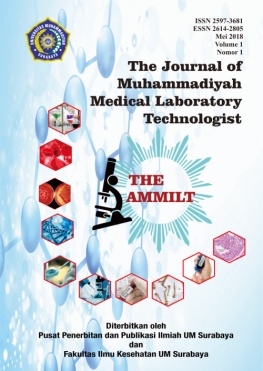Isi Artikel Utama
Abstrak
Â
ABSTRACT
Protein is the most important nutrients in the body, which serves as a new network-forming and maintaining or repairing worn tissue. Protein cucumbers reach 82% of his body. However, the protein can undergo denaturation when heated. Formulation of the research problem is whether there was an effect on long boiling sea cucumbers (Holothuria argus) the protein content. The research objective was to determine whether there is a long effect on the boiling sea cucumbers (Holothuria argus) the protein content.
This type of research is experimental. The study population was all kinds of sea cucumbers are caught by fishermen in Kel.Sukolilo Kec.Bulak Surabaya. The research sample is sea cucumber Holothuria argus species caught by fishermen in Kel.Sukolilo Kec.Bulak Surabaya. Research using the 5 treatments with 5 repetitions. Criteria longer boiling is P1 (0 min / control), P2 (15 min), P3 (30 minutes), P4 (45 minutes), and P5 (60 minutes).
Data examined protein levels by means of laboratory tests. Based on the laboratory results obtained average amount of 16.948% protein content in boiling 0 minutes, 13.068% in 15 minutes, 11.986% at 30 minutes, 10.652% at 45 minutes, and 8.732% in boiling water 60 minutes.Test results are then tested the statistical ANOVA showed significant values where 0.000 <0.05 (α). It can be concluded that there is a long effect on the boiling sea cucumbers (Holothuria argus) the protein content.
Keywords: Sea Cucumber & Protein Levels
Rincian Artikel
Referensi
- Alimul AA., 2010, Metode Penelitian Kesehatan Paradigma Kuantitatif, Surabaya, Health Books Publishing
- Anonim, 2005, Produk Olahan Hasil Laut Kota Surabaya, Surabaya, Dinas Pemantapan Pangan Pemerintahan Kota Surabaya
- Arisman, 2010, Gizi dalam Daur Kehidupan, Jakarta, Buku Kedokteran-EGC
- Barasi ME., 2007, At a Glance Ilmu Gizi, Jakarta, Erlangga
- Ghufran M., 2010, Cara Gampang MembudidayakanTeripang, Yogyakarta, Lily Publisher
- Mardiyah S., 2010, Handout Biokimia, Surabaya, Kalangan Sendiri
- Maryoto J., dkk, 2006, Budi Daya Teripang, Jakarta, Swadaya-PS
- Muchtadi D., 2010, Teknik Evaluasi Nilai Gizi Protein, Bogor, Alfabeta
- Nurrika D., 2007, Mengenal Gizi untuk Pemula, Bandung, Pribumi Mekar
- Rina, 2011, Analisis Protein, rinaherowati.files.wordpress.com/2011/10/2-analisis-protein_.pdf, Diakses pada tanggal 09 Mei 2012
- Sandi N., 2010, Manfaat Teripang, http://doktersehat.com/manfaat-teripang-hoi-sum-bagi-kesehatan/, Diakses pada tanggal 19 Februari 2012
- Sediaoetama AD., 1985, Ilmu Gizi untuk Mahasiswa dan Profesi, Jakarta, Dian Rakyat
- Sendih & Gunawan, 2006, Keajaiban Teripang Penyembuh Mujarab dari Laut, Jakarta, Agro Media pustaka
- Sudjana, 2005, Metoda Statistika, Bandung, Tarsito
- Sudarmadji S., dkk, 1981, Prosedur Analisa untuk Bahan Makanan dan Pertanian, Yogyakarta, Liberty
- Sutaman, 1992, Petunjuk Praktis Budi Daya Teripang, Yogyakarta, Kanisius
- Tejasari, 2005, Nilai-Gizi Pangan, Yogyakarta, Graha Ilmu
- Thenawijaya M., 1990. Dasar-Dasar Biokimia Jilid 1. Jakarta : Erlangga.
- Winarno F.G., 1992. Kimia Pangan dan Gizi. Jakarta : PT. Gramedia Pusaka Utama.
- Yazid & Nursanti, 2006, Penuntun Praktikum Biokimia Untuk Mahasiswa Analis, Yogyakarta, ANDI
- Yuniastuti A., 2008, Gizi dan Kesehatan, Yogyakarta, Graha Ilmu
- Zainudin & Muhammad, 2003, Metode Penelitian, Surabaya, Airlangga University Press
Referensi
Alimul AA., 2010, Metode Penelitian Kesehatan Paradigma Kuantitatif, Surabaya, Health Books Publishing
Anonim, 2005, Produk Olahan Hasil Laut Kota Surabaya, Surabaya, Dinas Pemantapan Pangan Pemerintahan Kota Surabaya
Arisman, 2010, Gizi dalam Daur Kehidupan, Jakarta, Buku Kedokteran-EGC
Barasi ME., 2007, At a Glance Ilmu Gizi, Jakarta, Erlangga
Ghufran M., 2010, Cara Gampang MembudidayakanTeripang, Yogyakarta, Lily Publisher
Mardiyah S., 2010, Handout Biokimia, Surabaya, Kalangan Sendiri
Maryoto J., dkk, 2006, Budi Daya Teripang, Jakarta, Swadaya-PS
Muchtadi D., 2010, Teknik Evaluasi Nilai Gizi Protein, Bogor, Alfabeta
Nurrika D., 2007, Mengenal Gizi untuk Pemula, Bandung, Pribumi Mekar
Rina, 2011, Analisis Protein, rinaherowati.files.wordpress.com/2011/10/2-analisis-protein_.pdf, Diakses pada tanggal 09 Mei 2012
Sandi N., 2010, Manfaat Teripang, http://doktersehat.com/manfaat-teripang-hoi-sum-bagi-kesehatan/, Diakses pada tanggal 19 Februari 2012
Sediaoetama AD., 1985, Ilmu Gizi untuk Mahasiswa dan Profesi, Jakarta, Dian Rakyat
Sendih & Gunawan, 2006, Keajaiban Teripang Penyembuh Mujarab dari Laut, Jakarta, Agro Media pustaka
Sudjana, 2005, Metoda Statistika, Bandung, Tarsito
Sudarmadji S., dkk, 1981, Prosedur Analisa untuk Bahan Makanan dan Pertanian, Yogyakarta, Liberty
Sutaman, 1992, Petunjuk Praktis Budi Daya Teripang, Yogyakarta, Kanisius
Tejasari, 2005, Nilai-Gizi Pangan, Yogyakarta, Graha Ilmu
Thenawijaya M., 1990. Dasar-Dasar Biokimia Jilid 1. Jakarta : Erlangga.
Winarno F.G., 1992. Kimia Pangan dan Gizi. Jakarta : PT. Gramedia Pusaka Utama.
Yazid & Nursanti, 2006, Penuntun Praktikum Biokimia Untuk Mahasiswa Analis, Yogyakarta, ANDI
Yuniastuti A., 2008, Gizi dan Kesehatan, Yogyakarta, Graha Ilmu
Zainudin & Muhammad, 2003, Metode Penelitian, Surabaya, Airlangga University Press

